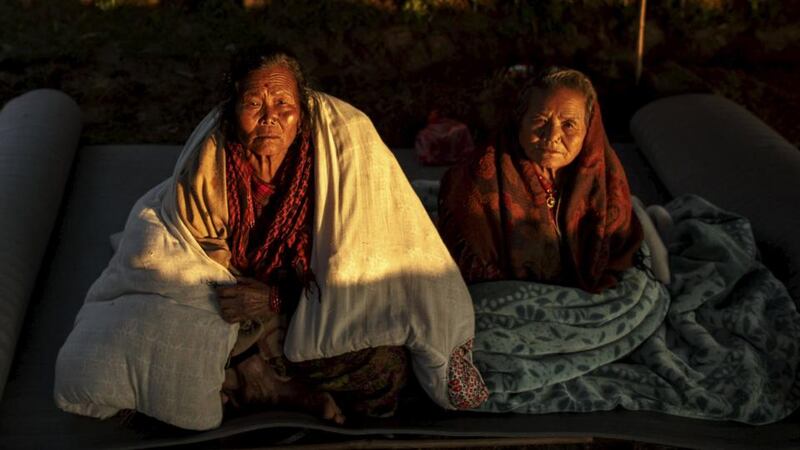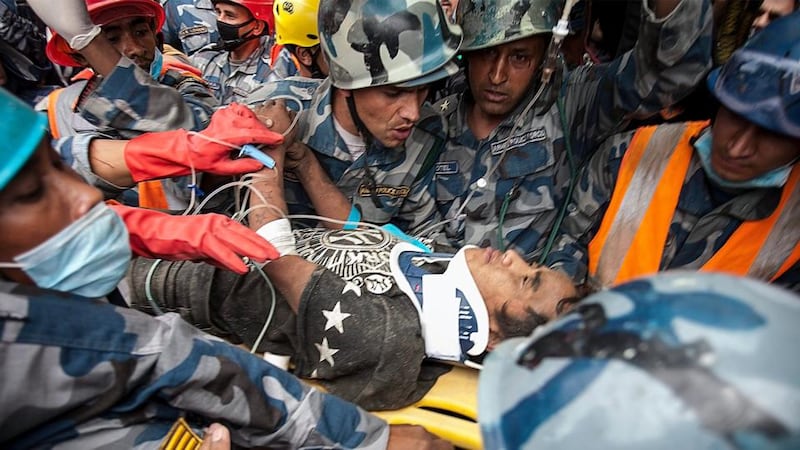Raj Kumar Sahi squats in the wreckage of his house in the village of Paslang, taking a break as he and his 25-year-old son, Sujan, a soldier in the Nepalese army, sift through the rubble of their home nearly a week after an earthquake that killed thousands of people in Nepal.
“This house was 30 years old, and built on the old house my father built. This is my ancestral home,” says Sahi, who is 40. Together with Sahi’s wife, Madhu, and daughter, Savita, the family are trying to build a temporary home before the rainy season comes.
Paslang is mostly gone, only a few of the 48 houses still standing after the devastating earthquake rocked Nepal at 11.56am on April 25th. Of the 300 inhabitants of the village, two died – a pregnant woman and a small child – and many more were injured. “Four of my relatives, including my two daughters, were buried here,” says Sahi, “but they were able to get out within 15 or 20 minutes of the earthquake.”


Sheets of corrugated metal absorbed the impact of falling masonry. The house was built of mud and, in part, concrete.
The story of Paslang, which is near the epicentre of the earthquake in the Gorkha district, is repeated all over the areas hit by the quake.
People are scared that the earthquake is coming back. They are angry about the pace of the relief effort, and there are rumours that local officials are stockpiling rice and other supplies for themselves. There have been no local elections for nearly 20 years, so there is no political structures to distribute aid.
About 700,000 houses were destroyed by the quake and 530,000 damaged. There are fears for the future: what is the point of rebuilding a house if the next tremor just knocks it down again? Should people move to the city instead?
Rainy season
The rainy season is imminent, and temperatures fall quickly in the evenings. Yet many people have no blankets or tents to shelter them. There has been extensive damage to the water supply, and setting up access to clean water is a challenge.
While 6,100 people are confirmed dead, Nepal’s prime minister, Sushil Koirala, has warned that the death toll could rise to more than double that figure.
Victims are being airlifted in by helicopter to the hospital in Gorkha. Many mountain roads have been blocked by landslides triggered by the earthquake.
Gorkha is where many of the Gurkha troops come from. Their bravery is renowned. It was once said of them: “If a man says he is not afraid of dying, he is either lying or is a Gurkha.”
But even the bravest people were overwhelmed by the scale of last week’s quake, and the next stage will be the widespread trauma that doctors fear could have wider repercussions in this developing country.
The political backdrop to this humanitarian crisis is one of conflict and uncertainty since civil war ended, in 2006, and the monarchy was abolished. Maoist rebels who had fought the government were taken into the political mainstream, but the legislature still lurches from crisis to crisis. In January there were fistfights in parliament over the terms of a constitution for the country.
At the same time as the women of Sahi’s family were being buried by rubble in Paslang, he and his son were in Kathmandu, four hours away, in a three-storey building that was collapsing under the weight of the 7.9-magnitude earthquake.
Sahi works as a security guard in Kathmandu to subsidise the family income from farming, and Sujan lives there with his pregnant wife.
Tent cities
Swathes of Kathmandu have been destroyed. The 19th-century Dharahara tower tumbled as the quake struck, taking many of the sightseers inside with it, and Durbar Square, in the heart of the city, bears scars of deep damage. Tent cities are springing up in lanes and at junctions.
People are leaving the city and drifting back to the villages, crowding the buses as they try to get on to the Prithvi Highway and back home.
The international aid effort has been impressive, with all the big agencies in evidence at the main focus points for disaster relief. But locals are concerned. “Aid is coming from overseas, but it is not being distributed quickly enough,” says one man in Gorkha. “We need tents; water and dried foods are a must.”
Oxfam Ireland, Concern and Plan Ireland were all on the plane from Abu Dhabi; it circled the airport for hours before being allowed to land at the small airfield that serves Kathmandu.
Plan Ireland has begun airlifting blankets, tents, tarpaulins, jerry cans and other essential items. The aid has been provided by Irish Aid, the Irish Government’s programme for overseas development.
Neighbouring China and India have both taken leading roles in aid provision.
Protecting the girl
“The earthquake is coming! Let’s go mum!” cries a little girl, Apeka, clasping a bag of dried noodles, which she eats like crisps.
Behind Apeka you can see the white tips of the Ganesh Hamil mountain range, which contains four peaks higher than 7,000m and 14 more higher than 6,000m.
Apeka’s mother, Anupa Sahi, her foot bandaged, tells how her own mother and sister protected the girl when the quake struck. The municipality has given them noodles and water so far, she says.
“We were inside and we were scared to death,” says Apeka’s 22-year-old sister, Anu Sani, whose arm was dislocated by a falling stone. “We are thinking about rebuilding the house but are not sure if we should do it here or elsewhere.”
The farmers grow maize and millet and raise goats and chickens. They are keen to point out that 50 animals were killed in the quake in Paslang, a level of destruction that will have a big impact on their livelihoods.
Susmila Thapamagar was killed trying to protect the child of her neighbour.
Khilbahabar Ranamagar is the uncle of the child who died. “She tried to save him, but they both died on the spot,” he says, resting a broken leg. “She managed to save another child of five years.”
Ranamagar voices a commonly heard frustration. “It will take up to seven months to build a house and cost around $10,000,” he says. We are pretty angry, as we are farmers, and it will take us a long time to make that kind of money, so we need temporary housing. And we are traumatised. We are terrified of it happening again. There is supposed to be another bigger quake this evening.”
Uplifting tales
It’s not all misery. The Nepalese spirit is strong, and there have been uplifting tales, such as that of the two people who were rescued from the rubble of buildings in Kathmandu, five days after the quake.
Even in the midst of so much destruction, people still celebrate life. En route to Paslang a wedding party has set up a giant pink tent, complete with plastic chairs, right in the middle of the road, blocking the way. They cheerfully part the seats and lift the flaps of the tent, and we drive through the wedding to get to Paslang.
A cheerful group of boys singing songs and carrying boxes of naan bread from India is a reminder that when aid does get through it’s a cause for celebration.
Darkness falls, and the snowy peaks of the Ganesh Hamil range fade from view. The people of Paslang lie down under a tarpaulin shelter to sleep, knowing they will awaken to an uncertain future tomorrow.










